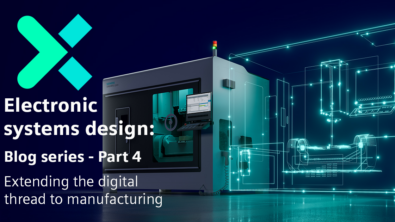Bridging the gaps in electronic systems design Blog series | The power of an integrated platform – Part 1


In today’s rapidly evolving electronics industry, companies face unprecedented challenges in developing complex, innovative products within tight schedules and budgets. As the demand for cutting-edge electronics grows, driven by the latest smartphone launches, wearable tech, and other groundbreaking devices, manufacturers are under immense pressure to deliver. However, the traditional approach to electronic systems design, characterized by disconnected tools and processes, often leads to inefficiencies that hinder progress and success.
This is the first in a series of four blog posts exploring the complexities of modern electronics design and how an integrated platform, like Siemens Xcelerator, can help companies overcome obstacles and drive innovation. Throughout this series, we’ll delve into the challenges faced by electronics companies, the benefits of an integrated solution, and real-world examples of how Siemens Xcelerator is transforming the industry.
The challenges of electronics development
Electronics companies face a myriad of challenges in today’s market. As products become more complex, managing the development process across multiple engineering disciplines becomes increasingly difficult. Siloed design processes, where mechanical, electronic, and software engineers work in isolation, using disconnected tools, can lead to costly errors, delays, and increased time-to-market.

Siloed design processes can lead to a 25% increase in development time and a 30% increase in costs (Source: Aberdeen Group, “Bridging the Gap Between Design and Manufacturing,” 2021). Additionally, the lack of collaboration and data consistency often results in design errors that are discovered late in the development cycle, leading to costly and time-consuming respins. On average, electronics companies experience 3-4 design respins per project, each costing up to $2 million (Source: Design007 Magazine, “Lee Ritchey on Reducing Respins by One,” 2020).
The power of an integrated platform
To overcome these challenges and bridge the gaps in electronic systems design, companies are turning to integrated platforms like Siemens Xcelerator. By providing a comprehensive suite of tools that support the entire product lifecycle, from concept to manufacturing, Siemens Xcelerator enables companies to:
- Streamline collaboration across disciplines: An integrated platform fosters seamless collaboration between mechanical, electronic, and software engineers, allowing them to work together efficiently and effectively.
- Enable the digital thread: Siemens Xcelerator creates a digital thread that connects all aspects of the product lifecycle, from requirements management to design, simulation, and manufacturing. This ensures data consistency and traceability throughout the development process.
- Reduce design errors and respins: By providing a single source of truth and enabling real-time collaboration, an integrated platform helps catch design errors early, reducing the need for costly and time-consuming respins.
- Accelerate time-to-market: With streamlined processes and a comprehensive set of tools, companies can accelerate product development and bring innovative electronics products to market faster.
This is a game-changer for electronics companies. By connecting all aspects of the product lifecycle, from design to manufacturing, the digital thread ensures data consistency and traceability, reducing errors and improving efficiency. This holistic approach to product development allows companies to make informed decisions, optimize their processes, and ultimately deliver higher-quality products to their customers.
Conclusion
As the electronics industry continues to evolve and become more competitive, companies must adopt new approaches to product development to stay ahead. By leveraging the power of an integrated platform like Siemens Xcelerator, companies can bridge the gaps in electronic systems design, overcome the challenges of increasing complexity, siloed processes, and time-to-market pressures, and ultimately drive innovation and success.
In the upcoming blog posts, we’ll take a closer look at how Siemens Xcelerator accelerates mechanical and electrical design, the role of simulation in optimizing electronics, and how the digital thread extends to manufacturing. Stay tuned for more insights and real-world examples of how Siemens Xcelerator is transforming the electronics industry.


